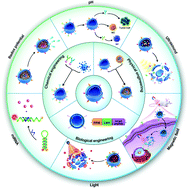Engineered extracellular vesicles as intelligent nanosystems for next-generation nanomedicine
Abstract
Extracellular vesicles (EVs), as natural carriers of bioactive cargo, have a unique micro/nanostructure, bioactive composition, and characteristic morphology, as well as fascinating physical, chemical and biochemical features, which have shown promising application in the treatment of a wide range of diseases. However, native EVs have limitations such as lack of or inefficient cell targeting, on-demand delivery, and therapeutic feedback. Recently, EVs have been engineered to contain an intelligent core, enabling them to (i) actively target sites of disease, (ii) respond to endogenous and/or exogenous signals, and (iii) provide treatment feedback for optimal function in the host. These advances pave the way for next-generation nanomedicine and offer promise for a revolution in drug delivery. Here, we summarise recent research on intelligent EVs and discuss the use of “intelligent core” based EV systems for the treatment of disease. We provide a critique about the construction and properties of intelligent EVs, and challenges in their commercialization. We compare the therapeutic potential of intelligent EVs to traditional nanomedicine and highlight key advantages for their clinical application. Collectively, this review aims to provide a new insight into the design of next-generation EV-based theranostic platforms for disease treatment.

- This article is part of the themed collections: Nanoscale and Nanoscale Horizons: Nanobiotechnology and Nanomedicine and Nanoscale Horizons 2023 Lunar New Year Collection


 Please wait while we load your content...
Please wait while we load your content...